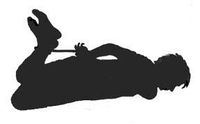Hogtie
The hogtie is a method of tying all four limbs together, rendering the subject immobile and/or helpless. Originally, it was applied to pigs (hence the name) and other young four-legged animals.
In more recent years, it has been applied to ways of restraining humans as well. Such restraints are employed in sexual bondage and by police forces.
Definition
The hogtie when used on pigs and cattle has the limbs tied in front; it is not possible to tie them behind without harming the animal. When performed on a human, however, a hogtie is any position that results in the arms and legs being bound, but usually pertains to hand and feet bound behind their back.
There is a significant risk of positional asphyxia in this position, in addition to the normal risks of restraint.
Use in bondage and torture
In hogtie bondage, the practice of sexual bondage named for it, the person who is being tied up is lain down flat on their belly, with ankles and wrists tied together behind the person's back.
A particularly dangerous variation of the hogtie has been used to torture and kill its victim: the hands are tied behind the back and the feet are tied together, with one end of the rope around the victim's neck. The tension on the neck-rope can only be relieved if the victim keeps their neck, back and legs arched. Eventually, the victim gets tired, relaxes, and strangles themselves.
Aspects of use in sexual bondage
The hogtie position in itself is particularly stringent as it places pressure on the abdomen, which might create difficulty in breathing. (See Positional asphyxia.) Depending on the flexibility of the person, even a "light" hogtie can be very uncomfortable and may not be maintained for very long.
The classic hogtie position has the wrists bound together then tied to the ankles. Depending on the person, this may be neither a particularly stringent nor an inescapable position. This method leaves the opportunity for the tied person to free themselves from the hogtie, as they may be able to reach any of the knots with their fingers.
The tied person can also be on his or her back. This can get uncomfortable after a while. Most people can turn over onto their front while hogtied, but if they are on a narrow sofa or bed, there is a danger of falling, especially if they are blindfolded. Tension might be relieved by rolling onto one's side, but if bondage is sufficiently stringent, the bound person may unable to roll themselves onto their side.
- Pictures of hogtied submissives - Photos by Robin Roberts
Advanced use in sexual bondage
In a vertical hogtie, the person is in a kneeling position with the feet off the ground. A person may be held in this position by tying ropes from the ceiling to secure them in place. This leaves the person balanced on their knees in a very difficult position to maintain and doubly painful.
This method of suspension bondage can take two forms. The first method starts with a conventional rope based hogtie, then by placing extra ropes around the upper body above and below the breasts as well as around the folded legs, these ropes can be used to lift the person into the air. Ropes can be placed in different areas to reduce the strain on the body being lifted in this manner.
The second method is far simpler, but has much greater risk of dislocation of the arms. The person may be tied with rope, but to reduce strain on the wrists and ankles suspension cuffs may be used. With the person lying on their stomach, their wrists and ankles are bound together, then from this point to the suspension line. When lifted, the person is suspended with their arms and legs behind them with all their weight taken by the wrists and ankles. While this position is completely inescapable, it is also a very stringent and painful position and can easily lead to serious injury if not practised correctly.
Variations
Often, additional bondage is combined with a hogtie. The knees are often tied together. A rope around the torso and arms, pressing the arms against the back, makes the arms more immobile. With a more flexible person, it is possible to add other bondage techniques such as elbow bondage, breast bondage, and crotch ropes. Having the head pulled back (see head bondage and hair bondage) can also dramatically increase the stringency of the position.
A variation to the hogtie is to tie the ankles to suitably tied elbow bondage. Depending on how close the ankles are drawn towards the elbow ropes, this can greatly increase the amount of tension that can be placed on the body, as well as leaving the knots controlling the position well out of reach of the bound person.
If the victim's arms are in a Single Glove, a hogtie may be achieved by tying the ankles to the tip of the glove.
Other hogtie positions may have the arms folded behind the back (possibly in a box tie) and the legs tied in a folded position by having ropes or leather straps around the ankle or shin and the thigh, keeping the leg in a bent position. With the arms in a box tie, drawing the ankles to be near the arms causes the back to arch.
Metallic handcuffs may be used in place of rope - sometimes referred to as a "Hogcuff" restraint.
See also
| Types of Hogties | ||
|---|---|---|
|
|
||
References
- Jay Wiseman's Erotic Bondage Handbook, Jay Wiseman, Greenery Press, 2000, < ISBN:1890159131 >: Pages 261-279
- Two Knotty Boys Showing You the Ropes, Two Knotty Boys, Green Candy Press, < ISBN:9781931160490 >: Pages 55-56
- Shibari You Can Use, Lee Harrington, < ISBN:9780615144900 >: Pages 98-99
- The Seductive Art of Japanese Bondage, Midori, Greenery Press, < ISBN:1890159387 >: Pages 139-150
- SM 101, Jay Wiseman, Greenery Press, Second Edition, < ISBN:0963976389 >: Pages 134-137
Chat rooms • What links here • Copyright info • Contact information • Category:Root


